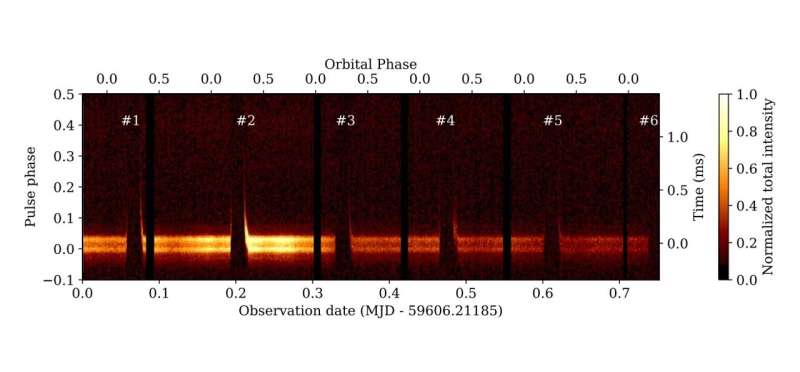July 30, 2024 report
This article has been reviewed according to Science X's editorial process and policies. Editors have highlighted the following attributes while ensuring the content's credibility:
fact-checked
preprint
trusted source
proofread
Astronomers observe eclipses of pulsar PSR J0024−7204O

Using the MeerKAT radio telescope, astronomers have observed eclipses in the radio emission of a pulsar known as PSR J0024−7204O. Results of the observational campaign, published on the preprint server arXiv, could help us better understand the nature and behavior of this pulsar.
The most rapidly rotating pulsars, those with rotation periods below 30 milliseconds, are known as millisecond pulsars (MSPs). Researchers assume that they are formed in binary systems when the initially more massive component turns into a neutron star that is then spun up due to accretion of matter from the secondary star.
A class of extreme binary pulsars with semi-degenerate companion stars is dubbed "spider pulsars." These objects are further categorized as "black widows" if the companion has extremely low mass (less than 0.1 solar masses), while they are called "redbacks" if the secondary star is heavier.
PSR J0024−7204O, or 47 Tuc O, is a black widow MSP in the globular cluster 47 Tucanae, with a spin period of 2.64 milliseconds. It is a binary system with an orbital period of 3.26 hours and a minimum companion mass of some 0.025 solar masses.
Previous observations of PSR J0024−7204O have detected eclipses of its radio pulsations, and now a team of astronomers led by Federico Abbate of the Cagliari Observatory in Italy has used MeerKAT to investigate the properties of these eclipses.
"We observed the eclipsing black widow pulsar 47 Tuc O with the MeerKAT radio telescope at UHF band (544-1,088 MHz) for 17 hours, covering 6 contiguous orbits (but only 5 full eclipses). Thanks to this observation we have been able to study in detail the properties of the eclipses and their variability over a succession of orbits," the researchers wrote in the paper.
MeerKAT observations found that dispersion measure excess of PSR J0024−7204O shows significant eclipse-to-eclipse variations, during both the ingress and egress stages. This suggests a higher gas density along the line of sight within the eclipsing region than in the surrounding orbital phases.
Furthermore, the observations identified strong scattering with time, which follows a similar trend to the dispersion measure. According to the astronomers, it indicates that scattering is most likely the dominant mechanism that causes the eclipses, at least in proximity of the ingress and egress regions.
The study also found that the polarization of PSR J0024−7204O shows a very significant drop during both the ingress and egress transition stages. The authors of the paper concluded that this, together with a small increase in the rotation measure, suggests the presence of a magnetic field of about 2.0 mG.
Summing up the results, the researchers noted that the duration of the eclipses of PSR J0024−7204O is similar to that of other black widow pulsars. Moreover, the maximum dispersion measure excess is comparable to that of the other eclipsing pulsars that were observed in a similar frequency range.
More information: F. Abbate et al, Study of consecutive eclipses of pulsar J0024$-$7204O, arXiv (2024). DOI: 10.48550/arxiv.2407.15563
Journal information: arXiv
© 2024 Science X Network





















